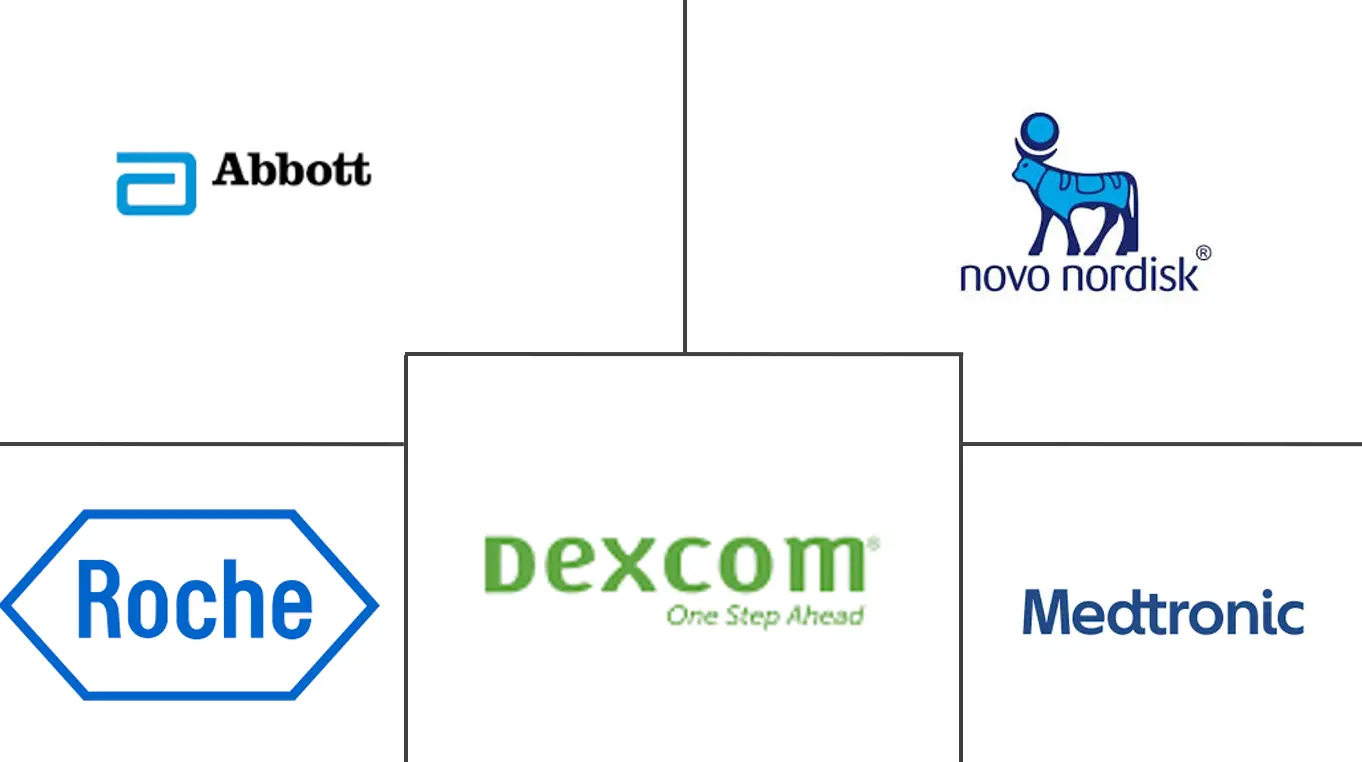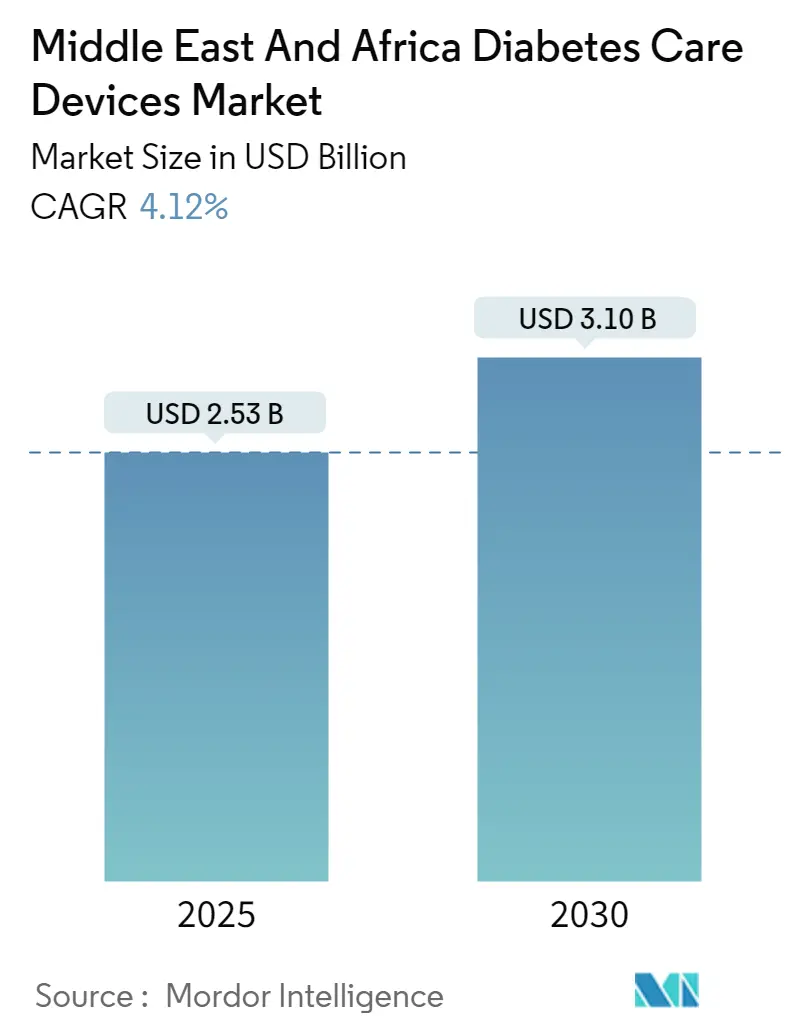
Middle East And Africa Diabetes Care Devices Market Analysis by Mordor Intelligence
The Middle East And Africa Diabetes Care Devices Market size is estimated at USD 2.53 billion in 2025, and is expected to reach USD 3.10 billion by 2030, at a CAGR of 4.12% during the forecast period (2025-2030).
The Middle East and African region had witnessed an alarming increase in the prevalence of diabetes, in recent years, the rate of diabetes is at an all-time high, mainly due to lifestyle changes. Diabetes is associated with many health complications. Patients with diabetes require many corrections throughout the day to maintain nominal blood glucose levels, such as administering additional insulin or ingesting additional carbohydrates by monitoring their blood glucose levels. Diabetes poses an emerging healthcare burden across the region.
73 million adults (20-79) are living with diabetes in the IDF MENA Region. This figure is estimated to increase to 95 million by 2030. 48 million adults in the IDF MENA Region are living with Impaired Glucose Tolerance, which places them at increased risk of developing type 2 diabetes. Diabetes is responsible for 796,000 deaths in the IDF MENA Region. USD 33 billion was spent on healthcare for people with diabetes.
Governments in the Middle East have identified the threat of diabetes and started to respond with various policies, initiatives, and programs. Six out of 15 countries in this region still do not have a national operational action policy for diabetes. Many countries still do not have a national strategy to reduce overweight, obesity, and physical inactivity, which are important risk factors for diabetes. Most counties have fully implemented national diabetes treatment guidelines. However, constant measures are being taken to minimize diabetic complications; therefore, owing to the aforesaid factors, the growth of the studied market is anticipated in the Middle East and African region.
Owing to the aforementioned factors the studied market is anticipated to witness growth over the analysis period.
Middle East And Africa Diabetes Care Devices Market Trends and Insights
Continuous glucose monitoring segment is expected to witness highest growth rate over the forecast period
The continuous glucose monitoring segment is expected to register a CAGR of 16.8% over the forecast period.
Continuous glucose monitoring devices are automated glucose monitoring systems that consist of a small device that can be worn on the body and held on by an adhesive patch. The sensor part of the device has a cannula that is inserted into the top layer of skin and uses samples of interstitial fluid to check glucose levels. Sensors are connected to a transmitter that can send data wirelessly to a dedicated mobile receiving device or smartphone.
The use of CGMs by people with diabetes and their caregivers and communities is beneficial for managing their blood glucose and insulin levels and maintaining their health outcomes. CGM makes it significantly easier to manage blood glucose levels by decreasing interruptions, allowing for better sleep, and improving the mental health of patients or caregivers by reducing the overall mental load of managing diabetes.
Continuous glucose monitoring sensors use glucose oxidase to detect blood sugar levels. Glucose oxidase converts glucose to hydrogen peroxidase, which reacts with the platinum inside the sensor, producing an electrical signal to be communicated to the transmitter. Continuous glucose monitoring has become a popular alternative to the portable finger-prick glucometers available on the market for the convenience of diabetic patients. Sensors are the most important part of continuous glucose monitoring devices.
A large variety of promising glucose-sensing technologies, from traditional electrochemical-based glucose sensors to novel optical and other electrical glucose sensors, have been developed, which has had a positive impact on market growth. Technological advancements to improve the accuracy of the sensors are expected to drive segment growth during the forecast period.
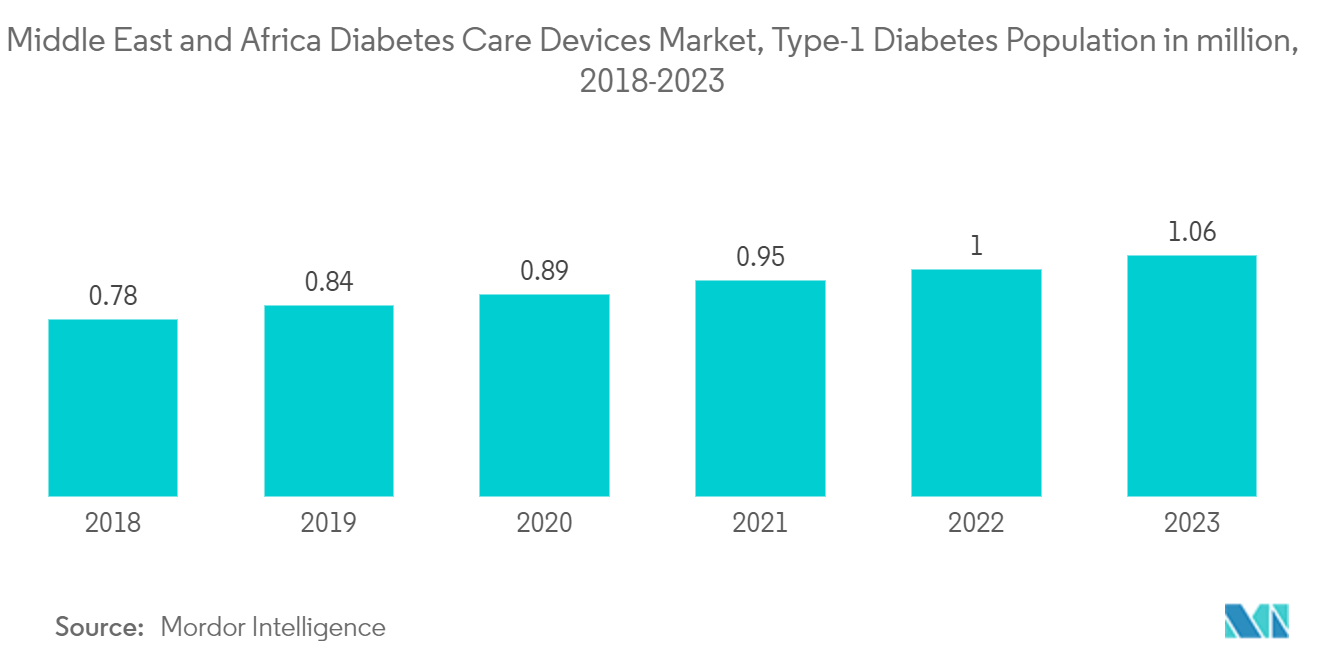
Saudi Arabia is expected to witness highest CAGR in the Middle East and Africa Diabetes Care Devices Market over the forecast period
Saudi Arabia is expected to register the highest CAGR of about 5.08% in the Middle East and Africa Diabetes Care Devices Market over the forecast period.
More than one in ten people in Saudi Arabia were living with diabetes, and the prevalence of the disease was expected to almost double by 2045, according to the report of the International Diabetes Federation. The report mentioned that 4.27 million people in Saudi Arabia have diabetes. The rise in the number of people with type-2 diabetes is driven by a complex interplay of socio-economic, demographic, environmental, and genetic factors. Key contributors include urbanization, an aging population, decreasing levels of physical activity, and increased levels of overweight and obesity.
The Saudi government announced in July 2022 that Saudi Arabia saw growing demand for quality healthcare services spurred by changes, including an increasing and aging population and a growing prevalence of lifestyle diseases such as diabetes and obesity. The government and private sector are both involved in working on healthcare entities, certifications, and regulations. The government is taking steps to have 100 percent of Saudi citizens covered by insurance and is working towards ensuring affordability, access, and quality digital healthcare and primary care with cost-effectiveness.
Therefore, owing to the aforesaid factors, the growth of the studied market is anticipated in the Middle East and Africa region.
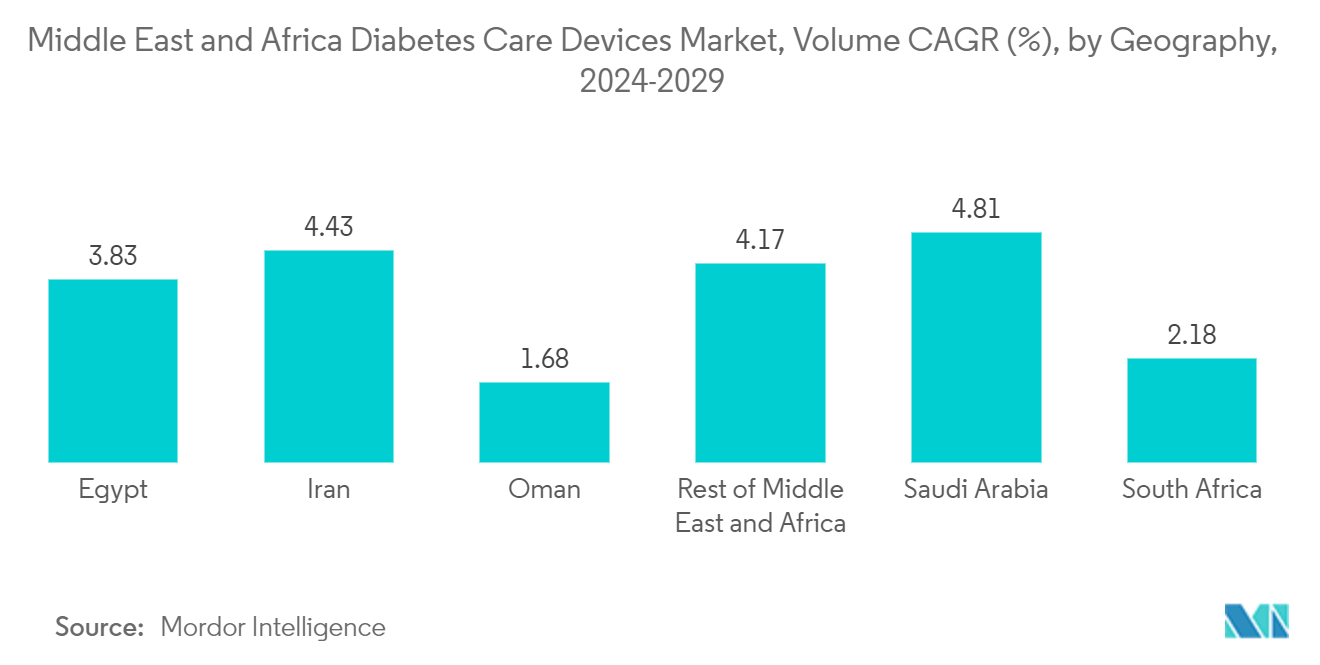
Competitive Landscape
The Middle East and African diabetes care device market is fragmented, with few significant and generic players. There have been constant innovations driven by manufacturers to compete in the market. The major players, such as Abbott and Medtronic, have undergone many mergers, acquisitions, and partnerships to establish market dominance while also adhering to organic growth strategies, which is evident from their R&D spending.
Middle East And Africa Diabetes Care Devices Industry Leaders
-
Abbott Diabetes Care
-
Medtronic PLC
-
Roche Diabetes Care
-
Dexcom Inc.
-
Novo Nordisk A/S
- *Disclaimer: Major Players sorted in no particular order
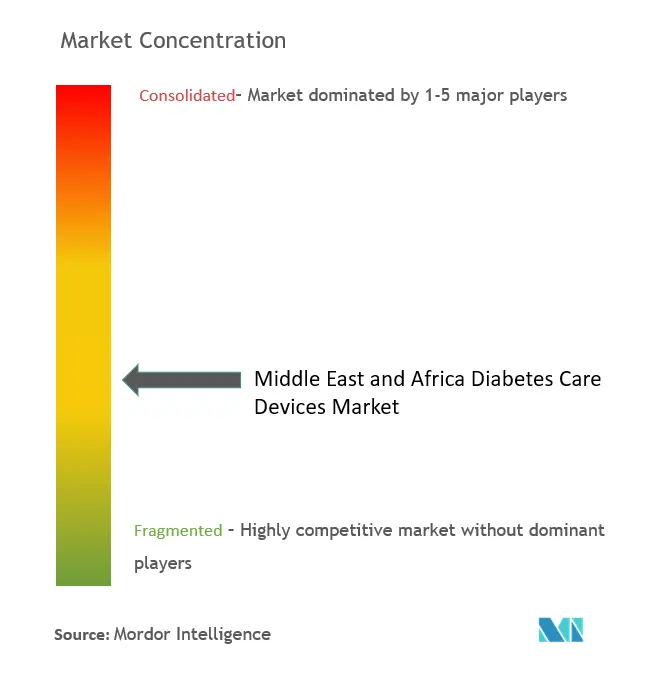
Recent Industry Developments
- August 2023: Nemaura Medical has received approval from the Saudi Food and Drug Authority (SFDA) for its non-invasive wearable glucose sensor, sugarBEAT. This approval follows more than a year of partnership with the SFDA through the company’s licensee in the Middle East, TPMENA, from which Nemaura previously received a provisional purchase order for 1.7 million sensors and 17,000 devices.
- October 2022: Becton, Dickinson, and Company and Biocorp announced that they signed an agreement to use connected technology to track adherence to self-administered drug therapies, like biologics. To support biopharmaceutical companies in their efforts to improve the adherence and outcomes of injectable drugs, the two companies would integrate Biocorp's Injay technology-a solution designed to capture and transmit injection events using Near Field Communication technology to the BD UltraSafe Plus Passive Needle Guard used with pre-fillable syringes.
Middle East And Africa Diabetes Care Devices Market Report Scope
Diabetes care devices are the hardware, equipment, and software used by diabetic patients to regulate blood glucose levels, prevent diabetes complications, lessen the burden of diabetes, and enhance the quality of life. The Middle East and African diabetes care device market is segmented by monitoring devices, management devices, and geography. The report offers the value (in USD) and volume (in units) for the above segments.
| Self-monitoring Blood Glucose Devices | Glucometer Devices |
| Blood Glucose Test Strips | |
| Lancets | |
| Continuous Glucose Monitoring Devices | Sensors |
| Durables (Receivers and Transmitters) |
| Insulin Pumps | Insulin Pump Monitor |
| Insulin Pump Reservoir | |
| Insulin Infusion Sets | |
| Insulin Syringes | |
| Insulin Disposable Pens | |
| Insulin Cartridges in Reusable Pens | |
| Jet Injectors |
| Saudi Arabia |
| Iran |
| Egypt |
| Oman |
| South Africa |
| Rest of Middle East and Africa |
| Monitoring Devices | Self-monitoring Blood Glucose Devices | Glucometer Devices |
| Blood Glucose Test Strips | ||
| Lancets | ||
| Continuous Glucose Monitoring Devices | Sensors | |
| Durables (Receivers and Transmitters) | ||
| Management Devices | Insulin Pumps | Insulin Pump Monitor |
| Insulin Pump Reservoir | ||
| Insulin Infusion Sets | ||
| Insulin Syringes | ||
| Insulin Disposable Pens | ||
| Insulin Cartridges in Reusable Pens | ||
| Jet Injectors | ||
| Geography | Saudi Arabia | |
| Iran | ||
| Egypt | ||
| Oman | ||
| South Africa | ||
| Rest of Middle East and Africa | ||
Key Questions Answered in the Report
How big is the Middle East And Africa Diabetes Care Devices Market?
The Middle East And Africa Diabetes Care Devices Market size is expected to reach USD 2.53 billion in 2025 and grow at a CAGR of 4.12% to reach USD 3.10 billion by 2030.
What is the current Middle East And Africa Diabetes Care Devices Market size?
In 2025, the Middle East And Africa Diabetes Care Devices Market size is expected to reach USD 2.53 billion.
Who are the key players in Middle East And Africa Diabetes Care Devices Market?
Abbott Diabetes Care, Medtronic PLC, Roche Diabetes Care, Dexcom Inc. and Novo Nordisk A/S are the major companies operating in the Middle East And Africa Diabetes Care Devices Market.
What years does this Middle East And Africa Diabetes Care Devices Market cover, and what was the market size in 2024?
In 2024, the Middle East And Africa Diabetes Care Devices Market size was estimated at USD 2.43 billion. The report covers the Middle East And Africa Diabetes Care Devices Market historical market size for years: 2019, 2020, 2021, 2022, 2023 and 2024. The report also forecasts the Middle East And Africa Diabetes Care Devices Market size for years: 2025, 2026, 2027, 2028, 2029 and 2030.
Page last updated on:
Middle East And Africa Diabetes Care Devices Market Report
Statistics for the 2025 Middle East And Africa Diabetes Care Devices market share, size and revenue growth rate, created by Mordor Intelligence™ Industry Reports. Middle East And Africa Diabetes Care Devices analysis includes a market forecast outlook for 2025 to 2030 and historical overview. Get a sample of this industry analysis as a free report PDF download.
